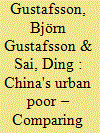| Srl | Item |
| 1 |
ID:
192330


|
|
|
|
|
| Summary/Abstract |
Using data from the China Household Income Project in 2013 and 2018, this paper studies relative poverty among rural hukou holders living in urban China and urban hukou holders. People living in households with an income below a fixed percent of the median per-capita income and wealth below the same fixed percent of the median per-capita wealth among urban residents are deemed as relative poor. Although migrants with rural hukou living in urban China were more prone to twice poverty than urban residents in 2013, this was not generally the case in 2018.
A multivariate analysis shows several factors to be related to the probability of being twice relative poor. Even considering these factors, a rural hukou status increased the probability of being twice relative poor in 2013. In contrast, such an excess risk of being twice relative poor was much lesser outspoken in middle and low-ranking cities in 2018. However, rural to urban migrants living in high-ranking cities had a somewhat higher risk of being relative poor than urban residents with the same characteristics in 2018.
|
|
|
|
|
|
|
|
|
|
|
|
|
|
|
|
| 2 |
ID:
187275


|
|
|
|
|
| Summary/Abstract |
This article compares receipt of dibao social assistance in rural and urban areas of China using household data from seven province-level units. The probability of dibao receipt is positively related to the number of persons in the household who are older, adults who do not work and to the possibility that the head of household is in poor health. Means testing based on household income is more stringent in urban areas while low household wealth is a more important factor of dibao receipt in rural areas. In rural China, membership of the Communist Party of China (CPC) increases the probability of dibao receipt. A larger proportion of ethnic minority households than majority households receive dibao.
|
|
|
|
|
|
|
|
|
|
|
|
|
|
|
|
| 3 |
ID:
090804


|
|
|
|
|
| Publication |
2009.
|
| Summary/Abstract |
While some workers in China attain senior professional level and senior cadre level status (Chuzhang and above), others attain middle rank including middle rank of professional and cadre (Kezhang). This aspect of the Chinese labour force has attracted surprisingly little attention in the literature, a fact which this paper aims to rectify. We define various segments of the urban population in work-active ages and use data from the Chinese Income Project (CHIP) covering eastern, central and western China for 1995 and 2002. For 2002, persons of high rank make up 3% and persons of middle rank make up 14% of persons in work-active ages.
|
|
|
|
|
|
|
|
|
|
|
|
|
|
|
|
| 4 |
ID:
089554


|
|
|
|
|
| Publication |
2009.
|
| Summary/Abstract |
This paper investigates how ethnic minorities in rural China are faring compared with the ethnic majority. The village is the unit of analysis and large surveys for 2002 are used. Minority villages in northeast China are found to have a somewhat better economic situation than the average majority village, but minority villages in the southwest are clearly faring worse. Industrialisation, inputs in agricultural production, stock of human capital of the labour force, wage level on the local labour market as well as indicators of path dependency are all found to affect the economic situation of a village. Location is the single most important circumstance working against a favourable economic situation for minority villages in the northwest and particularly the southwest. Low village income results in long-distance migration for many ethnic minorities, but for some minorities their ethnicity hinders migration.
|
|
|
|
|
|
|
|
|
|
|
|
|
|
|
|
| 5 |
ID:
141105


|
|
|
|
|
| Summary/Abstract |
Using a household sample survey for 2006, this article shows that the Hui population in the rural part of Ningxia Autonomous Region in China is disadvantaged compared to the Han majority as regards length of education and household per capita wealth. Yet, there is no gap in average disposable incomes between the two ethnic groups and poverty rates are very similar. This paradox is owing to members of Hui households earning more off-farm income than members of Han households. In particular, young Hui males living in poor villages have a remarkably high likelihood of migrating, thereby bringing back income to their households.
|
|
|
|
|
|
|
|
|
|
|
|
|
|
|
|